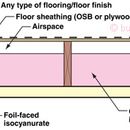Detail for garage ceiling insulation
I have a garage ceiling below my kitchen and dining room which is not really insulated. Based on info here and other places, my plan is to use 2×8 mineral wool but I’m not sure how I should air seal the subfloor from below. I read an article by Lstiburek(New Light in Crawlspces,2008) link here:
http://buildingscience.com/documents/insights/bsi-009-new-light-in-crawlspaces#F05
In it he has a detail(figure 7) that has polyiso under the joists as air barrier(and as vapor barrier though I think the air barrier is the real purpose here) and batt insulation in the cavity. The puzzling part is an air cavity is shown just below the subfloor and he specifically notes this as being important for warmer floors and as the proper detail for rooms over a garage. I always thought that a gap between insulation and the heated side of a wall cavity greatly negated R-value. What gives? Assuming the ends of a joist cavity are air sealed, it still seams that insulation would be better than empty space.
Also, one secondary question. Is the rigid insulation below the joists the best way to retrofit an air barrier? I know spray foam is the usual advice to achieve a retrofit air barrier but I’d like to avoid spray foam due to expense/quality control/and ability to run utilities later for kitchen renovation.
Thanks in advance for your attention and great site!
-Luke
.
GBA Detail Library
A collection of one thousand construction details organized by climate and house part










Replies
Luke,
Yes, that's one of Joe Lstiburek's famously quirky details. It works, but only if someone has done a meticulous job of air sealing the perimeter (rim joist area) and the ceiling. If this assembly has air leaks, the air space makes things worse.
Some building inspectors or Energy Star Homes programs may not accept Lstiburek's approach.
You don't have to include the air space if you don't want to. For more information on this issue, see How to Insulate a Cold Floor.
Thanks for the reminder of that article! I read that awhile ago which is one of the reasons I thought the air gap strange. One question about the rigid foam below: I don't think I have the ceiling clearance to add 1.5" foam but I hope to get 3/4". Is the 1.5" spec'd because of concern over dew point condensation? Also, can XPS be used or just the polyiso mentioned in Lstiburek article?
Luke,
In theory, the colder the climate, the thicker the rigid foam should be. In practice, however, thin foam is rarely a problem, because a garage isn't quite as cold as the great outdoors. I would say that 3/4-inch rigid foam is probably safe.
Green builders try to avoid the use of XPS because XPS is manufactured with a blowing agent that has a high global warming potential.